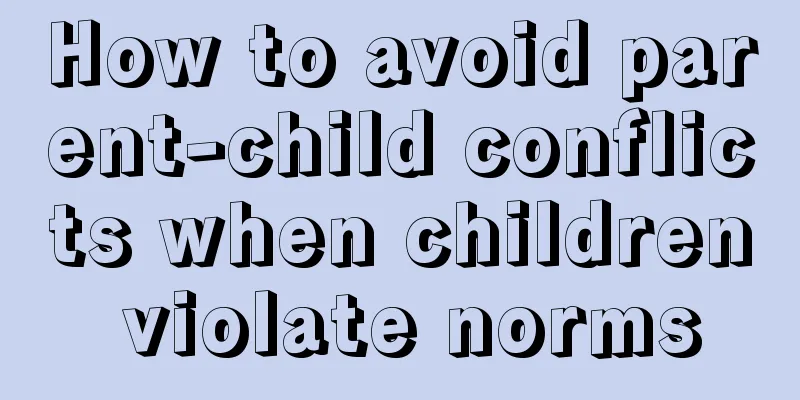How to avoid parent-child conflicts when children violate norms

|
Educating children is a lifelong task for parents. However, many parents are first-time parents. They are forced to act as life mentors before they are ready to be good parents. So how can we avoid conflicts with children when they violate the rules? What to do when your child disobeys youAn experienced preschool teacher can use effective methods to minimize conflicts between children and teachers. The key is to start with a "gentle but firm" attitude when reminding children to attract them. When I was working as a consultant at a Montessori kindergarten in Taipei City, a newly graduated kindergarten teacher named Xiaomi came to work in our kindergarten one morning. On her first day at work, she was assigned by the head teacher to a classroom for children aged 2 to 3 years old to assist the main teacher of the class. During the morning working hours, she saw that the children were independent, orderly, and focused in doing the work they chose. While marveling at the abilities of these children under the age of 3, she had a happy and satisfied smile on her face throughout the morning. I was tutoring in another classroom next to hers for children aged 3 to 6. When I saw her on her first day at work, she was so happy for the children and felt how meaningful life was, I thought to myself, "That's great, but you'll know when it's dinner time..." Time flies, and it's time for lunch. She was assigned to a large round table, responsible for taking care of four children around 2 and a half years old. After they put their hands together and read the thank you text, they started to eat. A satisfied smile still hung on Teacher Xiaomi's face. I accompanied the children in the middle and large groups to eat across a table, and at the same time, I ate and observed the whole environment. Of course, "observing new teachers" is also one of my jobs. As I expected, 10 minutes after the meal time, problems began to appear at Teacher Xiaomi's table. Because usually 2 and a half-year-old children can only concentrate on eating for about 10 to 15 minutes. A little girl named Axin, who was sitting next to Teacher Xiaomi, suddenly held the spoon in her right hand (like holding a stick) and raised it, and began to knock on the bowl, making a "hunk-hunk-hunk" sound. When Teacher Xiaomi saw that she was doing something wrong, she immediately reminded her. She smiled and said to Axin gently: "Axin? We are eating now. It will be very noisy if you knock on the bowl like this, which will disturb us! And you will not be able to continue eating. Come on, please put down the spoon, and we will continue to eat seriously, okay?" After being reminded by Teacher Xiaomi, Axin paused for two or three seconds, thinking about what to do next... Then, she looked at Teacher Xiaomi with an innocent smile, raised her hand holding the spoon, and continued to laugh and knock on the bowl. Obviously, Ah Xin had already answered the teacher with her actions: "Not good!" Teacher Xiaomi used the same method to remind her again, but Ah Xin continued to knock on the bowl, and the reminder was ineffective again. Teacher Xiaomi became more and more anxious, and she blurted out: "Please stop knocking on the bowl, if you do this again I will confiscate your spoon!" But at this time she suddenly realized that I had been observing her the whole time. She knew that threatening words like "If you do this again, I will ..." would not work in a kindergarten with ideals. So she had to swallow the words. However, the situation did not improve, but got worse. The three children at the same table saw that Axin successfully "challenged authority" and began to join in. In an instant, the four children were knocking on the bowls at the same time, playing the Four Seasons Concerto with a "hum-hum-hum-hum" sound, which was very lively. Teacher Xiaomi saw that she could not control the situation at the moment, her ears turned red, and she looked at the children at a loss and said, "Please stop knocking, okay?" The answer, of course, was: the four children looked at her and continued to knock on the bowls happily. In fact, after hearing Teacher Xiaomi say, "Ah Xin, we are eating now. It will be very noisy if you knock on the bowl like this. It will disturb us! And you can't continue to eat. Come on, please put down the spoon, and let's continue to eat seriously, okay?" When I said this, I thought to myself that this was not a good thing. Not to mention that this speech was long and weak, the worst thing was that it ended with the taboo word "OK". I often mention this important point to parents and teachers: children's compliance is not an invitation, and there is no need to add "OK?" to the end of the sentence. Seeing the situation getting out of control, I had to intervene. So I stood up, walked slowly to their table, and started using the "Four Steps of Reminder". "Four Steps of Reminders" to Reduce Conflicts between Adults and Children—Adults should maintain a "gentle but firm" attitude and not provoke children's emotions. I looked at Ah Xin's eyes with a "gentle but firm" expression, and slowly walked forward step by step towards her desk. When Ah Xin saw me walking towards her, she also looked at me. When I walked in front of her, I squatted down and continued to look at her. When she saw me squatting down and looking at her, she stopped knocking the bowl. I said two words to her in a "gentle but firm" tone: "Ah Xin." At this time, she looked at me with her eyes and her whole body was completely frozen. The other three children at the same table were also completely frozen. An experienced preschool teacher can use effective methods to minimize the conflict between children and teachers. The key is to start with a "gentle but firm" attitude when reminding, so as to attract the children. As the saying goes, "well begun is half done." Such preparatory steps can usually stabilize children in the present moment, just as it is said in "The Art of War": "Conquer the enemy without fighting." However, the next four steps are the key to truly affecting the educational results. Let's see how they evolve. Step 1: Describe the behavior you saw Then, I said to Axin in the same "gentle but firm" tone: "I saw you knocking the bowl." When Axin heard me say this, an exclamation mark seemed to appear above her head, and she thought about what she had just done. Objectively "describing the behavior you saw" is a very important step. Because sometimes when children are too excited, too happy, too tired, too angry, etc., they will unconsciously or irrationally do some disorderly behaviors. Of course, the child may also do it on purpose because he wants to know what the consequences will be if he continues to do so. But through our verbal guidance in this step, we can help him pull the focus back to himself in the present moment and make his behavior temporarily pause; even if it is only for one or two seconds, this is the key point of education. Note: Using blaming language to tell children will only provoke their opposition. Don’t use blaming words to tell them at this time, because the child’s OS will be as follows: "Hey! What are you doing?" (Child OS → banging the bowl!) "Stop! Why are you banging the bowl?" (Child OS → Because I want to!) "You're making a lot of noise, don't you know?" (Child OS → I don't know!) "Stop knocking, you hear me?" (Child OS → I didn't hear you!) These negative words are likely to cause children to feel antagonistic, making things more difficult to handle. Step 2: Tell your child why you shouldn’t do this Once the child has put the focus back on himself, what should you do next? Then I continued to use simple and powerful words to tell Ah Xin: "This is very noisy." After hearing this, Ah Xin's movements remained frozen, but it was obvious that her mind had begun to think about the reason why I reminded her. Through this step, we can let children understand or reconfirm the reasons why this behavior is inappropriate and why they should not continue to do it. Note: Remind your children that one key point is enough! 1. Your words should be concise and powerful, not lengthy and without focus. 2. There are many reasons not to knock on the bowl, but one key point is enough. If you want to explain it in detail, you should discuss it afterwards, not when giving the "Four Steps Reminder" at the moment. 3. Avoid using subjective blaming or critical words, such as: "Do you know that this is so noisy?" to prevent the child from developing an oppositional mentality, which will have the opposite effect. Step 3: Tell/demonstrate the correct way At this point, we have achieved the educational effect; next, to strengthen the child's positive learning of this matter, we need to use the reminder four steps 3. At this point, because I did not use any negative words or behaviors to provoke the child's emotions, she is still stable; so the initiative is still in our hands. Next, we need to tell her or show her what is the correct way. At this time, I gently took the spoon from Ah Xin's hand, put it on the three fingers of my right hand, and told her: "This is how we hold the spoon." Then, I said the most critical sentence in the "Four Steps of Reminder". I looked at Ah Xin, nodded slowly, and said with a smile: "Can I trust you to eat seriously now?" Ah Xin followed me and nodded. So I handed the spoon back to her. She took the spoon, slowly scooped a mouthful of rice and put it into her mouth. At this point, the winner was determined. Nodding and smiling while saying "Can I trust you now?" is the core guiding step in the "Four Steps of Reminder", and it is also an important key to let children gain positive learning experience from mistakes. In terms of words, the child hears "I believe you", and in terms of body language, the child sees us "nodding" to express affirmation, and he will feel that his incorrect behavior is tolerated and forgiven by us. He did not lose our love and trust because of doing the wrong thing; moreover, we are willing to believe that he will do the right thing. This is one of the specific ways we should cultivate children to "make mistakes their friends" in education. At the same time, please note that there is an art of speaking here. We use "question sentences" to ask children: "Can I believe you can do it now?" Through the guidance of positive words and body language, when children are asked at this time, they will naturally respond with a positive attitude, and say "Yes" with words or body language. When he says "Yes", he also confirms that he will do the right thing next, and bows for what he just did! Note: Trust your children and make them willing to follow the rules 1. After the child says "yes", adults should not treat the child with any suspicion, or say to the child: "Really? Will you really do that?" Such words have no educational effect. 2. Children are a mirror to us. They know themselves and build their own personality through our attitude towards them every day. Many times, they do what we want because we are willing to believe in them. 3. Children become great because we believe in them; they become small because we doubt them. Our doubts will only make them doubt their own value and our trust and love for them. 4. Finally, please remember that the question to be used here is: "Can I trust you?" instead of: "Why don't we come now?" The last three words "okay?" are often the culprit that causes many perfect guides to fail. Step 4: Give affirmation in the moment Finally, we need to put a perfect end to the child’s correct behavior by reminding them of the four steps. After seeing Ah Xin take the spoon, slowly scoop a mouthful of rice with the spoon and put it into her mouth... I looked into her eyes, nodded, and said to her with a sincere and affirmative tone, "Yes. Thank you." She listened to my praise and showed the shyness of "wanting to laugh but not daring to laugh." I felt that because of my affirmation, she was more sure that her current behavior was correct. When children do something wrong, we often remind them, blame them, criticize them, or scold them. But when they do something right, we are often reluctant to give them affirmation. However, it is very important for children to affirm them immediately after they correct their behavior. Because they can further confirm their behavior through us, and at the same time, it also increases their self-confidence and self-esteem. Note: Give sincere affirmation, exaggerated praise is not "children's needs" 1. We should give sincere affirmation instead of exaggerated praise, for example: "Wow! I think you are great now, you are awesome, have you seen that he is great now, yes..." 2. I often tell parents and teachers that these exaggerated ways of praising are just "adult romance" rather than "children's needs." Imagine if someone often praises you in this way, would you think he is sincere to you or is he acting? If we don't do this to adults, why do we do this to children? 3. After careful consideration, you may find that these are actually the practices of "adults looking down on children". We must know that our sincere affirmation will make children grow stronger and more confident in their positive behavior. Exaggerated praise is just a drama to make everyone laugh, and it has no great educational effect. Children who are used to adults’ exaggerated praise are prone to develop a habit of “demanding praise from others”. When they do something, they will immediately go to adults to show off and ask adults to “perform” for them. When adults do not “perform” with the same intensity, they may be unhappy, or lose interest and do not want to continue, or feel that they have not done well, so they become frustrated and discouraged. In fact, this is all due to the inappropriate guidance given by adults at the beginning, which results in the formation of inappropriate behavior in children. |
>>: When playing board games with your children, should you deliberately let your children win?
Recommend
What should I do if my baby has rough skin?
The temperature difference between indoor and out...
Can children with indigestion eat eggs? What are the reactions of children with indigestion?
Children have poor immunity and sometimes they do...
Can I eat donkey-hide gelatin during breastfeeding? What effect will eating donkey-hide gelatin have on the baby during breastfeeding?
Ejiao can regulate qi and blood, and I believe ma...
What are the differences between physiological jaundice and pathological jaundice in newborns?
The birth of a newborn is a great happiness for t...
What are the symptoms of baby eczema? What should I do if my child has cold hands and feet?
The skin of newborn babies is tender and sensitiv...
Will calcium deficiency affect children's sleep? Will calcium deficiency affect children's growth?
Usually, children's growth and development ca...
Can I eat fresh dates during breastfeeding? Can I eat fresh dates during breastfeeding?
During the lactation period, women are generally ...
How long does it take for baby rice cereal to stop? The correct way to brew baby rice cereal
Most mothers know that babies need to add complem...
What are the symptoms of neonatal jaundice? Treatment of neonatal pathological jaundice
If the bilirubin in the baby's body is too hi...
Can I eat peas during confinement? Is it good to eat peas during confinement?
Peas are a very common vegetable and are deliciou...
At how many months can premature babies be given complementary foods? Should complementary foods be added to premature babies be delayed?
At how many months can a premature baby be given ...
Why does my baby always pull his ears? 6 reasons for pulling ears
Taking care of children is a very hard job, and w...
Is it better for babies to drink goat milk or cow milk? Is it better for babies to drink goat milk powder or cow milk powder?
Many parents have no idea when choosing milk powd...
Is it better for the baby to lie down or to be held? How to hold a newborn baby?
Everyone loves newborn babies. So the question is...
At what age can children start sex education?
Experts say that children's sex education nee...









